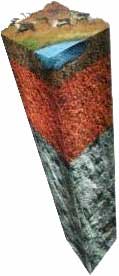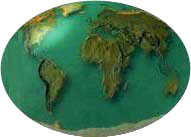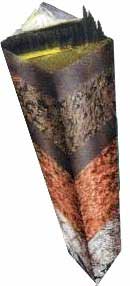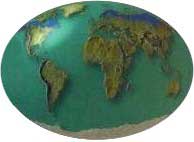|
|
|
The North hemisphere
contains two typical biomes, that
extends, one after the other, between
the polar regions and biomes located
more to the south. They are the tundra,
devoid of arboreal vegetation, and
taiga, forest mainly of coniferous.
The tundra
The tundra name
is applied, mainly, to the Arctic
regions of Asia that are between the
perpetual ice to the north and the
forests of taiga to the south. The
ground of the tundra remains frozen
most par of the year, and it melts
partially in summer. The water is
accumulated then in quagmires and
marshes.
In the tundra,
the aggravating factor is the temperature.
The average of annual precipitations
is low, around 250 mm, and the average
temperature is 25ª F, although
in winter temperature can reach -50°F.
The subsoil displays a permanent frozen
layer, whose thickness varies according
to the station. This ground layer
receives the name of permafrost.
|
| |
|
In the tundra, the
dominant forms of life are mosses
and lichens. In spite of the shortage
of rains, both forms grow well, because
the evaporation is almost nonexistent
and there are great humidity concentration.
The ground, poor
in organic substances, presents shortage
of nutrients. All the tundra is zone
of peat bogs, deposits of a fossil
fuel, the peat, formed by vegetal
remainders that were accumulated during
thousands of years in marshes. By
the intense cold, the decomposition
process is very slow and the fertile
ground formation is little.
The fauna of the
tundra also presents little diversity.
The two main species are the reindeer,
in Europe and Asia, and the caribou
in America. They are very similar
animals that, more likely, descend
from a common ancestor.
|
| |
 |
|
|
| The
ground of the tundra defrosts
only 2 or 3 times to the
year, originating small
water mirrors. The subsoil,
call permafrost, is permanently
frozen. |
|
|
|
|

GEOGRAPHIC
DISTRIBUTION OF THE TUNDRA
|
They are ruminats
mammalian of the family of the cervids,
and live in flocks.
Approximately, they
have a meter and a half of height
(the height of a quadruped, measurement
from the ground to the highest part
of the back). Its coat, very dense,
changes of the brown grey to white,
in winter.
They have spears,
with which excavate in the snow in
search of lichens, its food. They
migrate periodically, in agreement
with the cycles of reproduction of
the life forms of which they are nourished.
The reindeer domesticate,
and serve like shot and load animals
. Other mammals that feed on plants
and lichens are lemmings, species
of rat of field.
There are also arctic
hares, polar wolves, foxes, lynges
and bears, and until a type of wild
bovine adapted to the intense cold,
the almizclero ox. Many of these animals
hibernate, that is to say, enter in
a winter lethargy state , after having
accumulated reserves in their organism
during the brief warm season. The
variety of birds is greater: there
are nivales owls, palmípedos
like the goose and the colimb, and
the greater hawk than knows , gerifalte.
Other birds come from the south, and
find in the tundra the conditions
necessary to nest and reproduce.
|
|
|
During the little
summery days there are also jejenes
and mosquitos. It is surprising that
in zones as cold as this ones, these
insects get to reproduce until forming
gigantic clusters. In the short summer
season, part of the accumulated snow
melts, the subsoil of the tundra,
frozen throughout the year, it prevents
the drainage and pools and marshes
form.
The suspended water
reaches then sufficient temperatures
after the reproduction of the larvae
of the mosquitos.
Traditionally, the
tundra been has inhabited by eskimos
- hunters and fishermen- and also
shepherds of reindeer, moving from
the forests, in search of food for
their flocks and reach the tundra
at the less cold time of the year.
it is interesting to observe that
the life of these towns evokes in
certain way the one of the man called
of Cro-Magnon, a predecessor of the
present man who inhabited the region
of Dordoña, in the south of
France, about 30,000 years ago.
|
| |
|
| The
ground of taiga, put under
smaller cold than the one
of the tundra, allows the
development of arboreal
species, like the coniferous |
|
|
|
 |
| |
|

GEOGRAPHIC
DISTRIBUTION OF THE TAIGA
|
That zone, temperate
at the present time, was tundra in
those times. The archaeological discoveries
and the paintings of the caves in
which they lived, show similarities
with eskimos groups of the present
tundra.
Taiga
In Asia, to the
south of the tundra and to the north
of the steppe is a wooded cold climate
formation, with coniferous predominance..
This biome of the
north of Siberia, that has been called
taiga, also appears in the region
of the sea of the Hudson, in the north
of Canada.
|
|
|
In taiga, the aggravating
factors are the temperature and the
water. The average temperature is
of 19º C in summer, and -30ºC
in winter; the annual average of precipitations
is 10 - 30 inches.
In all this zone
the boreal forest grows, favoured
by climates less rigorous than those
of the tundra and by a ground that
suffers less the effect of snow .
The Scandinavian
countries, Siberia and Canada present
forests of firs, pines and larches,
and of birches. The fauna is composed
by animals that resist the cold, many
of which hibernate: elk, bisons, wolves,
bears, martas, lynges, squirrels,
marmotas, beavers, lemmings and deer.
|
|
| |
|
|
|

 cargando el contenido
cargando el contenido